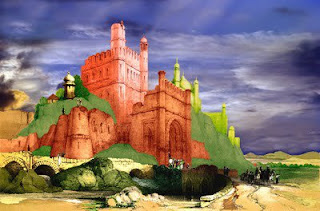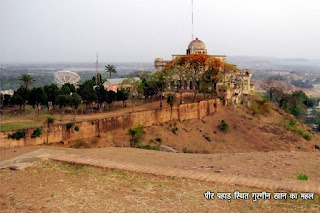In Odisha, Durga Puja is celebrated in two different ways, one is in Pandals that is Sarodiya Durga Puja which is started from the new moon day of Sukla Paksha and lasts till the Navami or ninth day of bright fortnight or Sukla Paksha. The other is in Shakti Peethas or temples dedicated to Shakti which starts from Ashtami tithi of Krishna Paksha and ends on Navami tithi of Sukla Paksha that is it starts from eighth day of dark fortnight and ends on ninth day of bright fortnight. This is also known as Sodasha Dinatmak ( 16 days festival).
There are many famous shrines of Mata, where she worshiped in various forms of Nava Durga or Dasha Mahavidya. Below, is picture of Suna Besha of Maa Chandi, Cuttack.
1- Goddess Vimala, Puri Jagannath Temple
2- Goddess Tara Tarini , Berhampur
3- Goddess Mangala, Kaktapur
4- Goddess Sarala, Jhankada, Jagatsinghpur
5- Goddess Biraja, Jajpur town
6- Goddess Hingula, Talacher
7- Goddess Samalei, Sambalpur
8- Goddess Chandi, Cuttack
9- Goddess Tarini, Keojhar
10- Goddess Kichakeswari, Khinching
11- Goddess Ambika, Baripada
12- Goddess Bhadrakali, Aharpada,Bhadrak
13- Goddess Ramachandi, Konark
14 - Goddess Bata Mangala, Balasore
15- Goddess Bhagabati, Banapur
16-Goddess Chamunda, Baitala Deula , Bhubaneswar
17- Goddess Bhattarika, Atagarh
18- Goddess Charchika, Banki
19- Goddess Chausathi Jogini, Outskirt of Bhubaneswar
20- Goddess Kali, Kalijai, Chillika
21- Goddess Ghanteswari, Sambalpur
22- Goddess Kanakdurga, Berhampur
23- Goddess Lankeswari, Sonepur
24- Goddess Ugra Tara, Khorda
25 - Goddess Maheswari, Atthamallik
26- Goddess Majhighariani, Rayagada
27- Goddess Manikeswari, Kalahandi
28- Goddess Saptamatruka, Jajpur
29- Goddess Siddha Bhairabi, Ganjam
30- Goddess Sureswari, Sonepur
Below is a picture of Maa Mangala, Kakatpur.
After from these temples, there are many other ancient temples that is dedicated to Maa Durga. All these temples, celebrate Durga Puja and Sodasha Upachara is done in most of these temples. Maa Durga is decorated with many ornaments, clothes to form many Besha out of which Suna Besha is quiet famous. Devotees visit the temple on these days and pray to Maa Durga and seek her blessings.
There are many famous shrines of Mata, where she worshiped in various forms of Nava Durga or Dasha Mahavidya. Below, is picture of Suna Besha of Maa Chandi, Cuttack.
Below, is a list of shrines devoted to Maa Durga in Odisha.
1- Goddess Vimala, Puri Jagannath Temple
2- Goddess Tara Tarini , Berhampur
3- Goddess Mangala, Kaktapur
4- Goddess Sarala, Jhankada, Jagatsinghpur
5- Goddess Biraja, Jajpur town
6- Goddess Hingula, Talacher
7- Goddess Samalei, Sambalpur
8- Goddess Chandi, Cuttack
9- Goddess Tarini, Keojhar
10- Goddess Kichakeswari, Khinching
11- Goddess Ambika, Baripada
12- Goddess Bhadrakali, Aharpada,Bhadrak
13- Goddess Ramachandi, Konark
14 - Goddess Bata Mangala, Balasore
15- Goddess Bhagabati, Banapur
16-Goddess Chamunda, Baitala Deula , Bhubaneswar
17- Goddess Bhattarika, Atagarh
18- Goddess Charchika, Banki
19- Goddess Chausathi Jogini, Outskirt of Bhubaneswar
20- Goddess Kali, Kalijai, Chillika
21- Goddess Ghanteswari, Sambalpur
22- Goddess Kanakdurga, Berhampur
23- Goddess Lankeswari, Sonepur
24- Goddess Ugra Tara, Khorda
25 - Goddess Maheswari, Atthamallik
26- Goddess Majhighariani, Rayagada
27- Goddess Manikeswari, Kalahandi
28- Goddess Saptamatruka, Jajpur
29- Goddess Siddha Bhairabi, Ganjam
30- Goddess Sureswari, Sonepur
Below is a picture of Maa Mangala, Kakatpur.
After from these temples, there are many other ancient temples that is dedicated to Maa Durga. All these temples, celebrate Durga Puja and Sodasha Upachara is done in most of these temples. Maa Durga is decorated with many ornaments, clothes to form many Besha out of which Suna Besha is quiet famous. Devotees visit the temple on these days and pray to Maa Durga and seek her blessings.




















































